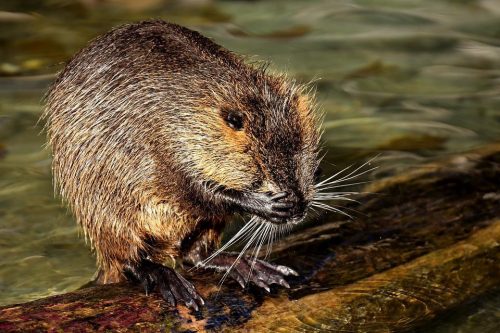Beavers are capable of blocking the passageway inside of culverts, but this problem can be solved by installing a grate at the intake end of the culvert. A hole has been cut in the grate, and the tube is put in there through that. The end of the tube that does not have any perforations is placed inside the culvert.

What will keep a beaver away?
Beavers, by felling trees and building dams, contribute to natural irrigation in uninhabited areas. However, when they do this in populated areas, they pose a significant threat to human safety and health. During the process, there is a risk that someone will get hurt or that property will be damaged. As soon as you notice that this is occurring, it is time to take action and direct the beaver to construct its dams in a different location. To reach this goal, one option could be to use beaver repellents and look into other possible deterrents.

- Homemade beaver repellant
Most people believe that you can save some money by preparing your own repellent, despite the fact that these products can be quite pricey. To create a beaver repellant that is comparable to Ropel, the only product on the market that is authorized for use as a beaver repellant, you will need a bucket with a capacity of one gallon and at least one can of paint that is of the white latex indoor type. In addition to that, you will require five cups of coarse sand.
After thoroughly combining the components of the repellent using a wooden spoon, you are now ready to use it. Paint the tree trunks in the area where there is evidence of beaver activity. You’ll need a paintbrush for this. In order for the mixture to dry on the trunks for a full day, we will need 24 hours. In the event that it rains before then, you will need to apply the mixture once again. The presence of this mixture prevents the beavers from ripping the bark off the trees.
- Fencing
If all you want to do is prevent beavers from destroying the trees on your property so that they can build their dams, beaver exclusion fencing is a good option. Beavers will not be able to chew through or pull apart a woven wire fence if it is wrapped around a tree using metal fasteners to create a secure enclosure around the tree. If the fence is going to be used around a tree, it needs to be at least 2-3 inches away from the area. This will ensure that the tree and any surrounding plants are able to develop normally and reach a height of at least 3 feet. Beavers are sneaky little critters that will eat parts of the tree that are above the fence if the fence is not high enough to keep them out. The bottom of the fence needs to be secured with stakes so that the clever beaver cannot try to lift it and squeeze under it. This will prevent the beaver from breaching the fence. If the stakes are not placed on the inside of the wire, the beaver will remove them instead by chewing them off. This can be a very labor-intensive task, particularly if you have more than one tree on your property and are doing it without any prior experience or training.
- Water Leveling Gadgets
Beavers can be kept under control with a wide variety of water levelers, both homemade and commercially available. Beavers will not become suspicious of a leak in the water supply because these devices allow the water level to be adjusted in such a way that there are no sounds of running water coming from the device, which would indicate that there is a leak.
This maintains the water level at the desired level without harming the beavers or destroying the dams they build. There are a number of these flow pipes, or water leveling devices, that have been inserted through the beaver dam in order to assist the water in exiting the dam. However, constructing one of these can be challenging, and if it isn’t done correctly, it could end up costing you money.
- Trapping
Because you have the ability to relocate the beavers yourself to another location, trapping is an excellent method for warding off and preventing beavers from returning. You can rest assured that you won’t run into them ever again if you do it this way. There are laws in place in certain states that prohibit the capture and transportation of beavers to other regions.
— Remember to Read Our Article: Is It Legal To Kill Beavers —-
The reason for this is to ensure that a problem caused by beavers does not spread to another location. When attempting to capture a beaver, it is recommended that you first check with the laws of your state. Locating the area in which a beaver spends the majority of its time grubbing is the most effective strategy for removing a beaver from its habitat.
The live trap must then be placed in the middle of the trail leading to the area, but it must be camouflaged so that the beaver does not decide to take an alternate path. Putting leaves all around the perimeter of the trap is one way to accomplish this goal. You will need bait to place on the trip pan that is located on the inside of the trap. This will encourage the beaver to continue moving toward the trap. It can be filled with wood, corn, or any other type of vegetation, and as soon as the beaver attempts to take it, the door to the trap will safely shut behind him.

Why do beavers block culverts?
Beavers prefer to construct their dams in locations that require the least amount of labor but will result in the greatest amount of water obstruction. A beaver’s perception of a culvert in a roadbed is probably similar to that of a breach in a dam. Therefore, beavers find road culverts to be very appealing places to construct their dams. The entire roadbed can be converted into a dam with just a little bit of effort spent blocking the culvert. This can cause major flooding and damage to the road, as well as safety problems and repairs that cost a lot of money.
What Makes Penguins’ Feathers Unique?
Penguins’ feather anatomy revealed: Penguins boast a remarkable feature their unique feathers. These feathers are designed with specialized barbs and hooks that interlock, creating a waterproof and insulating layer. This ingenious adaptation allows penguins to navigate ice-cold waters while maintaining a warm body temperature. Truly a testament to the incredible evolution of these remarkable creatures.
How do you repel beavers naturally?
Ineffective beaver repellents are currently on the market, which makes it difficult to keep these animals at bay. But if you avoid certain plants in your yard and remove shrubs and trees from the area around ponds and other bodies of water, you should be able to keep these animals from living in your yard.










